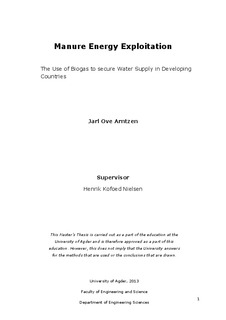| dc.description.abstract | This thesis has investigated the feasibility to produce electricity for water pumping in developing countries by using a simple biogas reactor system with an internal combustion. This was done by visiting Katulani Secondary School (SS) in Kitui, Kenya. Here a biogas reactor fed with pig manure produces biogas currently used for cooking. A grid connected water pump owned by the school is also located here. Data collection through measurements and interviews was done during 8 days. 10 tests gave an average methane content of 57.9 %. This resulted in a lower heating value of 4.94 kWh/m³ based on ambient conditions. 9 tests showed average hydrogen sulfide and ammonia concentrations in the gas of 2,000 ppm and 5 ppm respectively.
The results of this work showed that the pigs at Katulani SS do not currently produce enough manure to cover the cooking demand of about 12 m³ biogas. Biogas can therefore not in addition be used for water pumping before measures are taken to increase the feedstock quantity. Measures could be to change fodder type, increase number of pigs, improve slurry mixture or apply co-digestion.
At an obtained gas production of about 17.1 m³ biogas per day, 5.1 m³ biogas is available to be used in an engine. This thesis shows that at a required water supply of 5 m³ per day, an otto gas engine could be chosen if the compression ratio of the engine is increased. The otto engine has the advantage that it can run solely on biogas. A pilot-injection engine could also be chosen. This engine might be more suitable due to its ability to run at lower biogas volumes and to pump more water at the same volume of biogas compared to otto engines. A minimum diesel injection of 15 % would cost 9.81 Kenyan shillings (KES)/m³ water.
The results of the thesis shows that there is a potential for using biogas in a low-complex system for pumping water at low costs compared to using grid electricity. At the same time, there is additional synergy effects as pork meat, quality manure fertilizer and alternatively through taking advantage of the engine exhaust. | no_NO |
